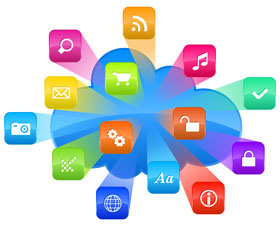WEEK 2 » LESSON CONTENT
Introduction • Operating Systems • Cloud Computing
• Mobile Tools and Applications • iGeneration

From shopping, purchasing movie tickets, “chatting,” and entertainment to online banking, conducting research, and accessing up-to-the-minute news, the Internet has found its way into almost all aspects of our daily, if not hourly lives. The variety of uses for the Internet on mobile devices is exponentially growing. Did you know that in one 24-hour period we, as humans generate enough new information to fill the Library of Congress 70x? Pretty amazing!
A key piece to how we handle all of this new data is the way we access this information. We used to have to sit in front of a computer to search the Internet, but now, due to the advent of mobile devices, we have tablets and smartphones that are light, portable, and powerful. The world now literally fits in your pocket or purse. We have become the “Always On” iGeneration. This week you will explore this mobile world and the foundational principles that make it possible. You then will consider all of the amazing possibilities mobile technology offers to you as an iTeacher. The key is to find what works for you and your students.
Operating Systems
Many individuals, when asked about their current operating system, look puzzled and confused. It is a concept we’ve all heard before – a computer operating system, but what is it, what does it do, and why do we need one?
An operating system is the liaison or link between your hardware and your application software. It is itself a type of software, but more specialized and high-functioning. We refer to this as the system software. Basically, the operating system is what facilitates interaction between the different parts of the hardware and what allows the application software programs to run.
Why are there so many different operating systems? In one word – competition! Each computer company creates a unique operating system that works only with their devices. Microsoft uses Windows, Apple uses iOS, and and Google phones use Android, just to name a few. Since each operating system varies from the others, and we don’t have time in an eight-week course to examine the software and applications used with each OS, for this course, the focus will be on Apple iOS used by the iPad, iPhone, and iPod Touch. As Apple has just introduced a new version of its operating system, you might want to download this great guide to iOS 7 for busy teachers.
The Cloud

One of the key mechanisms that make mobile devices and wireless connections even more powerful is the Cloud. This may conjure up in your mind documents and photographs floating around in space. Let’s take a few minutes and explore what is meant by the term “cloud computing” by reviewing the following YouTube video:
Cloud Computing: How it All Works
How can cloud computing help in the field of education? What are the benefits of cloud computing to the educational institutions which implement it? According to leading experts:
- Cloud computing allows teachers and administrations to access information from anywhere in the world in a matter of seconds. As a teacher, this means you have constant access to new information.
- With Cloud computing, you can access an incredible number of applications and other useful tools, often free of charge.
- Cloud computing allows students to experience and learn more about the world around them.
- Cloud computing promotes students guiding their own learning process, with the teacher as the mentor and facilitator
The possibilities are endless. Students who are absent from school can still access homework assignments or instruction, teachers no longer have to rely on the school’s network server being able to run a particular software, teachers can easily provide resources to supplement in-school learning (like apps), and parents can more easily become involved with the learning process.
Mobile Applications
With a traditional computer or laptop, you use application software programs to accomplish your task. The same is true of mobile devices, but instead of being called software or applications, these programs are usually referred to as apps. In this course, you will have the opportunity to explore a number of different, pre-screened apps in a variety of content areas. Just as you previously evaluated software to determine which was based on educationally sound principles, we will look at how you can determine which apps go beyond bright colors, fancy graphics, and music to actually teach students to master core concepts.
Old (educational and other software programs) Versus New (apps)
Prior to apps, users (all of us) and school districts purchased software (both productivity and educational), and unless we purchased a site license, it could only be used on one computer. Typically, most software was expensive and when updated, we had to purchase it all over again.
Over the years, users and schools have spent tens of billions of dollars on software that did not do what it was advertised to, and often, many parts were never used by users, teachers, and students. The software was often loaded on a computer in the classroom or computer lab, so your students did not have access to it on home computers. You had to schedule time to use the computer lab, and if you were lucky, you got it an hour a week and then you had to deal with all of the computer and software related problems. Thank goodness, those days are almost gone! As an iTeacher, you won’t use traditional software; you will use and integrate apps. As you progress through this class, you will be reminded again and again why apps are user-friendly, yet so powerful!
More on Selecting Apps for Use with Your Students
What should you look for when selecting a new app? You can take several different approaches. You can ask your friends, family, and colleagues to recommend the apps they find to be most useful. Another good place to start is with reputable magazines and Web sites, as they often publish lists of top Apps. You can check their reviews and comments, and then try out those that most interest you.
Here are a few places to start:
iPad Apps for Schools
The Best iOS Apps for Mobile Learning
31 Top Apps for Education from FETC 2013
Once you have identified those apps that “might be” useful for you in working with your students, you can go look for that particular app. When you go to the App Store and explore an app, check out the Ratings and Reviews section that contains comments and ratings by users. Many popular apps have hundreds of comments. Popular education apps are reviewed by teachers. Thus, before downloading an app, you can review what other users and/or teachers think of it. In addition, app developers take these comments seriously and app updates are a result of user feedback. Wow! It gets even better, you do not pay for app updates, as they are almost always free!
The 55 Best Free Education Apps For iPad

Speaking of cost, some apps require you to purchase them; however, you often can download a free “light” or limited version that contains advertising. This is a great way to evaluate apps before you purchase them. Also, Apple allows you to download a “purchased app” on up to five Apple devices under one Apple password. So, you can purchased an app and then download it to other iPhones and iPads in your iFamily. Never could do that with most traditional software!
Not all great educational apps are just for students. There are some wonderful tools for teachers, too – apps that will help you use your limited time more productively. Some educators and others think that an iPad is just an eBook reader, Web surfing device, for games, or for watching videos and movies. As you will learn in this course, an iPad is most definitely a powerful and functional computer and you can easily turn it into a small laptop or netbook computer. First, you might want to use an external keyboard and there are many options, two are listed below. The neat thing about these keyboards is you also get an iPad case; they connect to your iPad using Bluetooth, and most only need to be charged every 30 days or so. Remember to shop around as you can probably find a good one for 50% off the suggested retail price or around $50.
Zagg iPad keyboard/case
Belkin keyboard case
Next, you will want to add some productivity tools. You can download Apple productivity tools as apps, many for less than $10, like Keynote (presentation software), Pages (word processing), and Numbers (spreadsheets) from the App Store. You might be more familiar and comfortable with Microsoft Word and PowerPoint and don’t want to learn new word process or presentation software, and we don’t blame you.
Not to worry! Yes, you can have Windows and a full version of Microsoft Office on your iPad and you can download it as an app absolutely free. To learn how, click or tap here to learn about an app called OnLive and a few other useful productivity type apps we reviewed for you.
Suggested Readings
Click or tap here to access this week’s list of articles, Web sites, and/or videos that will help you explore additional information that can assist you in becoming an iTeacher and increase your excitement about all the possibilities! Remember, each week you will find a variety of resources that can help you further investigate the various topics that are covered.
If you have completed reading this page, continue to the iLearning in Action page.